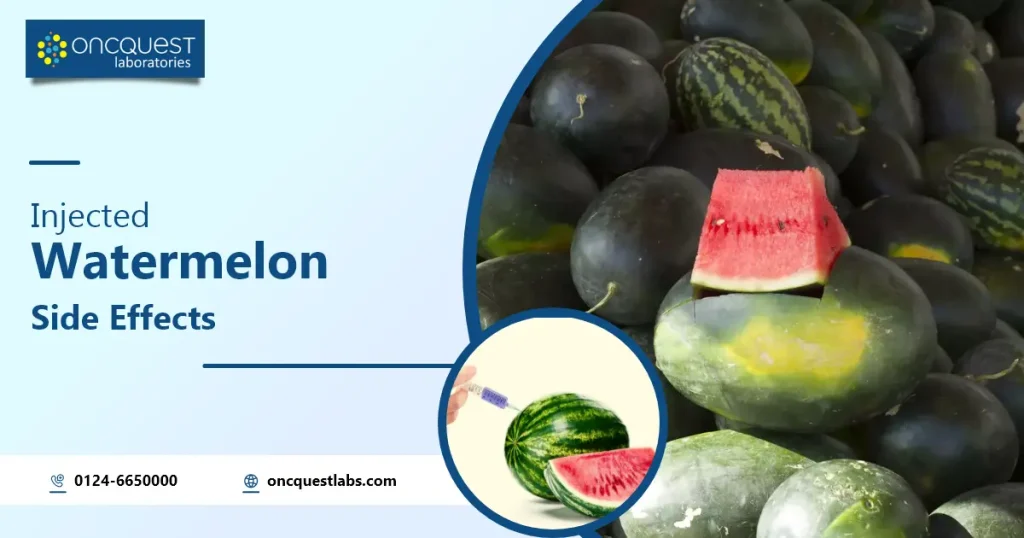Injected watermelons are fruits that have been artificially enhanced through the injection of various substances, such as chemicals, dyes, and sugar solutions. This practice aims to improve the watermelon’s appearance by making the flesh more vibrant, enhance its taste by increasing sweetness, and extend its shelf life. These modifications are often employed to make the fruit more appealing to consumers and to reduce spoilage during transportation and storage.
Contents
Common Substances Used in Watermelon Injection
Food Dyes
Food dyes are artificial colorants added to watermelons to enhance their red or pink color, making them look more appealing and fresher. These dyes are often synthetic and can sometimes be linked to allergic reactions or other health concerns.
Sweeteners
Sweeteners, including sugar and artificial sweeteners, are injected to make the watermelon taste sweeter than it naturally would. This improves the flavor but can also introduce substances that may not be healthy, especially if consumed in large quantities.
Preservatives
Preservatives are chemicals used to extend the shelf life of watermelons, preventing them from spoiling too quickly. While they help in reducing waste, preservatives can sometimes cause digestive issues or other health problems in sensitive individuals.
Growth Hormones and Chemicals
Growth hormones and other chemicals might be used to increase the size and yield of watermelons. These substances can interfere with natural growth processes and may have unknown long-term health effects on consumers, including potential hormonal imbalances.
Injected Watermelon Side Effects
Injected watermelons, while visually appealing, can carry several health risks due to the substances introduced during the injection process. Here are some potential side effects:
1. Allergic Reactions:
Injected watermelons may provoke allergic reactions due to added substances like food dyes or preservatives. Allergic responses can range from mild symptoms like skin rashes and itching to severe reactions such as swelling and difficulty breathing. Individuals with known food allergies or sensitivities should exercise caution when consuming injected watermelons, as these additives can trigger adverse immune responses. It’s crucial for consumers to read food labels carefully and be aware of potential allergens present in injected fruits to avoid any health complications.
2. Toxicity and Poisoning:
Toxicity and poisoning from injected watermelons can result from the ingestion of harmful substances introduced during the injection process, such as preservatives or chemicals. Symptoms may include nausea, vomiting, diarrhea, and abdominal pain. In severe cases, prolonged exposure to these toxins may lead to organ damage or an increased risk of developing cancer. It is essential for consumers to be aware of these potential risks and to exercise caution when consuming injected watermelons, opting for natural or organic alternatives whenever possible to minimize health hazards.
3. Metabolic and Endocrine Disruptions:
Metabolic and endocrine disruptions resulting from injected watermelon consumption can have significant health implications, particularly for vulnerable populations like children and pregnant women. The introduction of growth hormones and other chemicals into watermelons may interfere with the body’s natural hormone regulation systems, leading to imbalances in metabolism and endocrine functions. These disruptions can manifest as various health issues, including irregularities in growth and development, disturbances in reproductive health, and metabolic disorders. Given the potential risks, consumers should exercise caution and prioritize natural, unadulterated food options to safeguard their health and well-being.
4. Chemical Contamination:
Chemical contamination in injected watermelons refers to the presence of residues from pesticides, preservatives, or other agricultural chemicals used during cultivation. These contaminants can pose health risks to consumers, as prolonged exposure through consumption may contribute to the accumulation of harmful substances in the body. Symptoms of chemical contamination may include nausea, vomiting, and long-term health effects such as organ damage or increased cancer risk. It is essential for consumers to be aware of the potential hazards of chemical contamination in injected watermelons and to prioritize food safety by choosing natural, organic alternatives whenever possible.
5. Nutritional Imbalance:
Nutritional imbalance in injected watermelons occurs when the natural vitamins and minerals are altered or reduced during the injection process. This manipulation can lead to a skewed nutritional profile, potentially depriving consumers of essential nutrients. Injected substances, such as sweeteners and preservatives, may dilute the fruit’s natural nutrients or introduce harmful additives. Consequently, consuming these altered watermelons could contribute to dietary deficiencies and compromise overall health. Maintaining awareness of nutritional imbalances in injected watermelons is crucial for making informed dietary choices and prioritizing consumption of natural, unadulterated foods for optimal nutrition.
How to Identify Injected Watermelon
Identifying injected watermelons can be challenging, but there are several visual and sensory cues that consumers can look out for:
- Unnatural Appearance: Injected watermelons may have unusually bright or intense colors that look unnatural compared to their non-injected counterparts. Look for watermelons with a more muted, natural coloration.
- Irregular Shape or Texture: Inspect the surface of the watermelon for irregularities or uneven textures. Injected watermelons may have bumps, indentations, or uneven patches that indicate the injection process.
- Uniformity in Color: While natural watermelons often have variations in color and tone, injected watermelons may have a more uniform color throughout the flesh, indicating artificial enhancement.
- Unusual Firmness: Injected watermelons may feel unnaturally firm or hard compared to natural watermelons. Press gently on the surface to assess the firmness and texture of the fruit.
- Presence of Injection Holes: Carefully examine the watermelon for small puncture marks or holes where substances may have been injected. These marks may be visible on the surface or near the stem end of the fruit.
- Smell and Taste: Trust your senses – if the watermelon smells or tastes overly sweet or has an artificial flavor, it may have been injected with sugars or flavorings. Natural watermelons should have a fresh, subtle aroma and a sweet, refreshing taste.
By paying attention to these visual and sensory cues, consumers can better identify injected watermelons and make informed choices when selecting fruits for consumption.
Conclusion
identifying injected watermelons requires a keen eye for visual and sensory cues. Consumers should look out for unnatural colors, irregular shapes, uniformity in color, unusual firmness, presence of injection holes, and artificial smells or tastes. By being vigilant and knowledgeable about these indicators, consumers can minimize the risk of consuming injected watermelons and prioritize their health and well-being. Additionally, advocating for transparent labeling and supporting initiatives for stricter regulations on food additives can further safeguard consumer interests. Ultimately, making informed choices and opting for natural, organic alternatives whenever possible is essential for maintaining a healthy and balanced diet.





